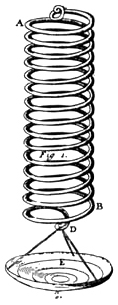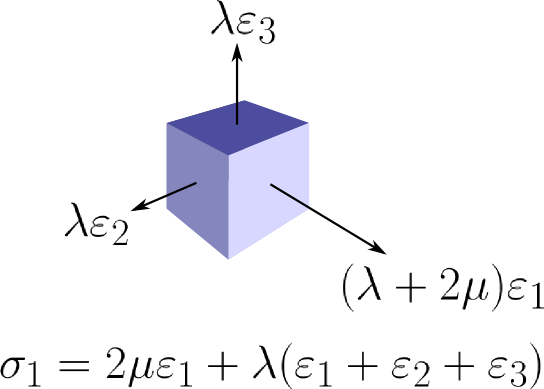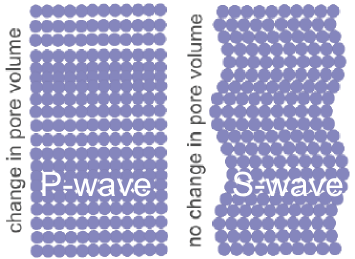L is for Lambda
/
Hooke's law says that the force F exerted by a spring depends only on its displacement x from equilibrium, and the spring constant k of the spring:
.
We can think of k—and experience it—as stiffness. The spring constant is a property of the spring. In a sense, it is the spring. Rocks are like springs, in that they have some elasticity. We'd like to know the spring constant of our rocks, because it can help us predict useful things like porosity.
Hooke's law is the basis for elasticity theory, in which we express the law as
stress [force per unit area] is equal to strain [deformation] times a constant
This time the constant of proportionality is called the elastic modulus. And there isn't just one of them. Why more complicated? Well, rocks are like springs, but they are three dimensional.
In three dimensions, assuming isotropy, the shear modulus μ plays the role of the spring constant for shear waves. But for compressional waves we need λ+2μ, a quantity called the P-wave modulus. So λ is one part of the term that tells us how rocks get squished by P-waves.
These mysterious quantities λ and µ are Lamé's first and second parameters. They are intrinsic properties of all materials, including rocks. Like all elastic moduli, they have units of force per unit area, or pascals [Pa].
So what is λ?
Matt and I have spent several hours discussing how to describe lambda. Unlike Young's modulus E, or Poisson's ratio ν, our friend λ does not have a simple physical description. Young's modulus just determines how much longer something gets when I stretch it. Poisson's ratio tells how much fatter something gets if I squeeze it. But lambda... what is lambda?
 λ is sometimes called incompressibility, a name best avoided because it's sometimes also used for the bulk modulus, K.
λ is sometimes called incompressibility, a name best avoided because it's sometimes also used for the bulk modulus, K. - If we apply stress σ1 along the 1 direction to this linearly elastic isotropic cube (right), then λ represents the 'spring constant' that scales the strain ε along the directions perpendicular to the applied stress.
- The derivation of Hooke's law in 3D requires tensors, which we're not getting into here. The point is that λ and μ help give the simplest form of the equations (right, shown for one dimension).
The significance of elastic properties is that they determine how a material is temporarily deformed by a passing seismic wave. Shear waves propagate by orthogonal displacements relative to the propagation direction—this deformation is determined by µ. In contrast, P-waves propagate by displacements parallel to the propagation direction, and this deformation is inversely proportional to M, which is 2µ + λ.

Lambda rears its head in seismic petrophysics, AVO inversion, and is the first letter in the acronym of Bill Goodway's popular LMR inversion method (Goodway, 2001). Even though it is fundamental to seismic, there's no doubt that λ is not intuitively understood by most geoscientists. Have you ever tried to explain lambda to someone? What description of λ do you find useful? I'm open to suggestions.
Goodway, B., 2001, AVO and Lame' constants for rock parameterization and fluid detection: CSEG Recorder, 26, no. 6, 39-60.
I shared this post on the Rock Physics discussion group on LinkedIn, and it garnered a good response from the usual online contributors. As Colin Sayers states in the comments below, Lambda has no physical meaning. It is first and foremost a mathematical contrivance to make equations in continuum mechanics simpler. Which raises a few important questions. Why do we invert seismic data for impedances, then algebraically rearrange them for a non-physical parameter such as Lambda.Density? Are we misrepresenting physics by spinning it into something that is seems intuitive, when really it is not?
Judging from the comments on LinkedIn, it appears that my post touched on all the major elements of Lambda, without going into all of the math. Some claim it is an important property for discriminating fluid types in a reservoir, others say it doesn't contain any more information than P-impedance and S-impedance. It is a little worrysome that the discussion is torn. If we can't even agree on it's utility, does that tell us that it is not very remarkable?








 Except where noted, this content is licensed
Except where noted, this content is licensed